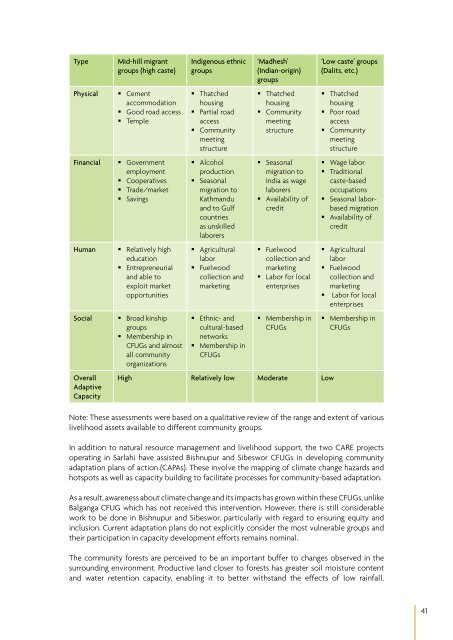Adaptation case studies.pdf - RECOFTC
Adaptation case studies.pdf - RECOFTC
Adaptation case studies.pdf - RECOFTC
You also want an ePaper? Increase the reach of your titles
YUMPU automatically turns print PDFs into web optimized ePapers that Google loves.
TypePhysicalFinancialHumanSocialOverallAdaptiveCapacityMid-hill migrantgroups (high caste)• Cementaccommodation• Good road access• Temple• Governmentemployment• Cooperatives• Trade/market• Savings• Relatively higheducation• Entrepreneurialand able toexploit marketopportunities• Broad kinshipgroups• Membership inCFUGs and almostall communityorganizationsIndigenous ethnicgroups• Thatchedhousing• Partial roadaccess• Communitymeetingstructure• Alcoholproduction• Seasonalmigration toKathmanduand to Gulfcountriesas unskilledlaborers• Agriculturallabor• Fuelwoodcollection andmarketing• Ethnic- andcultural-basednetworks• Membership inCFUGs‘Madhesh’(Indian-origin)groups• Thatchedhousing• Communitymeetingstructure• Seasonalmigration toIndia as wagelaborers• Availability ofcredit• Fuelwoodcollection andmarketing• Labor for localenterprises• Membership inCFUGsHigh Relatively low Moderate Low‘Low caste’ groups(Dalits, etc.)• Thatchedhousing• Poor roadaccess• Communitymeetingstructure• Wage labor• Traditionalcaste-basedoccupations• Seasonal laborbasedmigration• Availability ofcredit• Agriculturallabor• Fuelwoodcollection andmarketing• Labor for localenterprises• Membership inCFUGsNote: These assessments were based on a qualitative review of the range and extent of variouslivelihood assets available to different community groups.In addition to natural resource management and livelihood support, the two CARE projectsoperating in Sarlahi have assisted Bishnupur and Sibeswor CFUGs in developing communityadaptation plans of action (CAPAs). These involve the mapping of climate change hazards andhotspots as well as capacity building to facilitate processes for community-based adaptation.As a result, awareness about climate change and its impacts has grown within these CFUGs, unlikeBalganga CFUG which has not received this intervention. However, there is still considerablework to be done in Bishnupur and Sibeswor, particularly with regard to ensuring equity andinclusion. Current adaptation plans do not explicitly consider the most vulnerable groups andtheir participation in capacity development efforts remains nominal.The community forests are perceived to be an important buffer to changes observed in thesurrounding environment. Productive land closer to forests has greater soil moisture contentand water retention capacity, enabling it to better withstand the effects of low rainfall.41
















